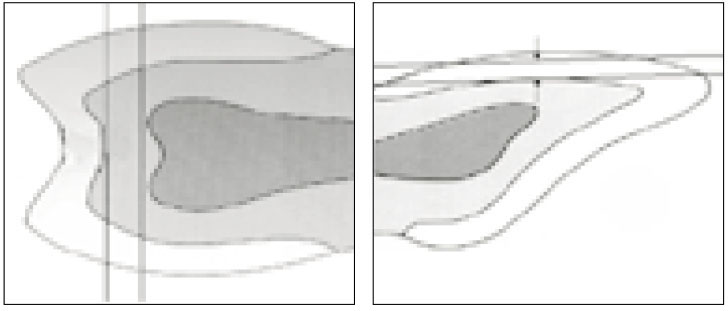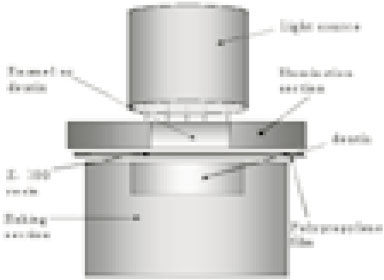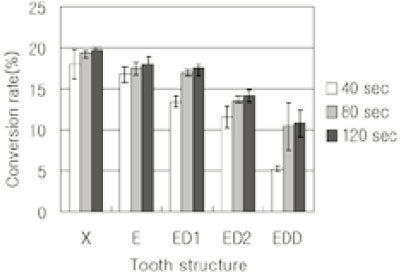J Korean Acad Conserv Dent.
2002 Jan;27(1):16-23. 10.5395/JKACD.2002.27.1.016.
A study on the degree of conversion of light curing composite resin according to the thickness of tooth structure penetrated by light and applied light curing time
- Affiliations
-
- 1Department of Conservative Dentistry & Institute for Oral Bioscience, College of Dentistry, Chonbuk National University, Korea.
- KMID: 2175544
- DOI: http://doi.org/10.5395/JKACD.2002.27.1.016
Abstract
- Physical properties of composite resins such as strength, resistance to wear, discoloration, etc depend on the degree of conversion of the resin components. The purpose of this study was to evaluate the degree of conversion of the composite resins according to the thickness of tooth structure penetrated by light and applied light curing time. The coronal portions of extracted human teeth (one anterior tooth, three posterior tooth) was embedded by pink denture material. the mounted teeth were cut into three illumination sections (1mm thickness enamel section, 1mm thickness dentin section, 2mm thicknes dentin section) and one backing section with cutting wheel. Thin resin films were made by using 6kg pressure between slide glass during 5 minutes. Thin resin film was light cured on coupled illumination section during 40sec, 80sec and 120sec. each illumination section was coupled as follows; no tooth structure(X), ename section(E), enamel section + 1mm dentin section(ED1), enamel section + 2mm dentin section(ED2), enamel section + 1mm dentin section + 2mm dentin section(EDD). To simulate the clinical situation more closely, thin resin film was cured against a backing section of tooth structure. The degree of conversion of carbon double bonds to single bonds in the resin films were examined by means of Fourier Transform Infrared Spectrometer. The results were obtained as follows; 1. As curing time was increased, conversion rate was increased and as tooth thickness which was penetrated by curing light was increased, conversion rate was decreased. 2. At all tooth thickness groups, conversion rate between 80sec and 120sec was not significantly increased(P>0.05). 3. At 40sec group and 80sec, conversion rate between no tooth structure(X) group and 1mm enamel section(E) group was not significantly decreased(P>0.05). 4. At 80sec group and 120sec, conversion rate between 1mm enamel section(E) group and 1mm enamel section + 1mm dentin section(ED1) group was not significantly decreased(P>0.05).
MeSH Terms
Figure
Cited by 1 articles
-
Surface hardness of the dental composite cured by light that penetrate tooth structure according to thickness of tooth structure, light intensity and curing time
Soo-Kyung Cho, Dong-Jun Kim, Yun-Chan Hwang, Won-Mann Oh, In-Nam Hwang
J Korean Acad Conserv Dent. 2005;30(2):128-137. doi: 10.5395/JKACD.2005.30.2.128.
Reference
-
1. Cook WD. Factor affecting the depth of cure of UVpolymerized composites. J Dent Res. 1980. 59:800–808.
Article2. Reinhardt KJ, VAhl J. Zur Frage der Aushartung und photo polymeriaierbarer kpmposiste in Unterschnitten. Dtsch Zahnarztl Z. 1981. 36:8–10.3. Inai Y, et al. The importance of polymerization initiator system and interfacial initiation of polymerization in adhesive bonding of resin to dentin. J Dent Res. 1991. 70:1088.
Article4. Ruyter IE, Svendsen SA. Remaining methacrylate group in composite restorative materials. Acta Odontol Scand. 1978. 36:75–82.5. Grassie N. Chemistry of high polymer degradation process. 1956. Bulter worth pub;255.6. Ruyter IE, Oyased H. Compressive creep of light cure resin based restorative materials. Acta Odontol Scand. 1982. 40:359–364.7. Inoue K, Hayashi I. Residual monomer(Bis-GMA) of composite resin. J Oral Rehabil. 1982. 9:493–497.8. Cook WD. Spectral distributions of dental photopolymerization source. J Dent Res. 1982. 61:1436–1438.
Article9. Jordan R. Esthetic composite bonding, technique and materials. 2nd ed. Mosby Year Book;20.10. Heigl J, Bell M, White J. Application of infrared spectroscopy to the analysis of liquid hydrocarbon. Analytical chemistry. 19:293.11. Bowen RL. Dental filling material comprising vinylsilane treated fused silica and a binder consisting of the reaction product of bisphenol and glycidyl methacrylate. US Patent. 1962, 3, 066, 112.12. Full CA, Hollander WRL. The composite resin restoration. A literature review part III. what the future holds. ASDC J Dent Child. 1993. 60:57–60.13. Ferracane JL. Using posterior composites appropriately. J Am Dent Assoc. 1992. 123:53–58.14. Ruyter IE. Vanherle G, Smith DC, editors. Monomer systems and polymerization. posterior composite resin. dental restorative materials. 1985. Amsterdam: Peter Szule Publishing Co.;109–126.15. Mannual of Z-100 composites.16. Ruyter IE, Oysaed H. Conversion in different depth of ultraviolet and visible light actived composite materials. Acta Odontol Scand. 1982. 40:179–192.
Article17. Koran P, Kürschner R. Effect of sequential versus continuous irradiation of a light-cured resin composite on shrinkage, viscosity, adhesion and degree of polymerization. Am J Dent. 1998. 11(1):17–23.18. Yang HS, Park YJ. The Effect of Composition on the Mechanical Properties of. J Korean Dent Assoc. 1989. 27:185–199.19. Swarz ML, Phillips RW, Rhodes B. Visible light activate resins-depth of cure. J Dent Res. 1982. 61:270.20. Ferracane JL, Greener EH. Fourier transform infrared analysis of degree of polymerization in unfilled resins--methods comparison. J Dent Res. 1984. 63:1093–1095.
Article21. Kim D, Min BS, Choi HY, Park SJ, Choi GW. A study of physical properties of composite resin polymerization with argon laser. J Korean Acad Conserv Dent. 1998. 23:1–19.22. Chung K, Greener EH. Degree of conversion of seven visible light-cured posterior composites. J Oral Rehabil. 1988. 15:555–560.
Article23. Koenig JL. Fourier transform infrared spectroscopy of polymers. Advances in polymer science. 89–147.
Article24. Guerra RM, et al. FTIR monomer conversion analysis of UDMA-based dental resins. J Oral Rehabil. 1996. 23:632–637.
Article25. Kim KH, Kwon OS, Kim HG, Baek KC, Um CM, Kwon HC. A study on the degree of conversion of light curing composite resin according to the depth of cure and light curing time. J Korean Acad Conserv Dent. 1997. 22(1):35–53.26. Moon AJ, Kim BH, Cho BH, Kwon HC. Changes of the degree of conversion and shear bond strength according to the monomer ratio of experimental bonding resins. J Korean Acad Conserv Dent. 1999. 24(1):26–39.27. Peutzfeldt A. Resin composite in dentistry the monomer systems. Eur J Oral Sci. 1997. 105:97–116.28. Asmussen E. Factors affecting the quantity of remaining double bond in restorative resin polymers. Scand J Dent Res. 1982. 90:490–496.
Article29. Peutzfeldt A. Quantity of remaining double bonds of propanal-containing resins. J Dent Res. 1994. 73(10):1657–1662.
Article30. Eliades GC, Vougiouklais GJ, Caputo AA. Degree of double bond conversion in light cured composites. Dent Mater. 1987. 3:19–25.31. Tarle Z, Meniga A, Ristic M, Sutalo J, Pichler G, Davidson CL. The effect of the photopolymerization method on the quality of composite resin samples. J Oral Rehabil. 1998. 25:436–442.
Article32. Fan PL, Stanford CM. Effect of backing reflectance and mold size on polymerization of photoactivated composite resin. J Dent Res. 1984. 63:1245–1247.
Article33. Standlee JP, Caputo AA, Hokama SN. Light cured composites. CDA J. 1988. 16:25–28.34. Weaver WS, Blank LW, Pelleu GB. A visible light activated resin cured through tooth structure. Gen Dent. 1988. 36:236–237.
- Full Text Links
- Actions
-
Cited
- CITED
-
- Close
- Share
- Similar articles
-
- Polymerization ability of several light curing sources on composite resin
- Comparison of the shear bond strength of brackets in regards to the light curing source
- Comparison of light transmittance in different thicknesses of zirconia under various light curing units
- Surface hardness of the dental composite cured by light that penetrate tooth structure according to thickness of tooth structure, light intensity and curing time
- Comparison of Surface Microhardness of the Flowable Bulk-Fill Resin and the Packable Bulk-Fill Resin according to Light Curing Time and Distance





